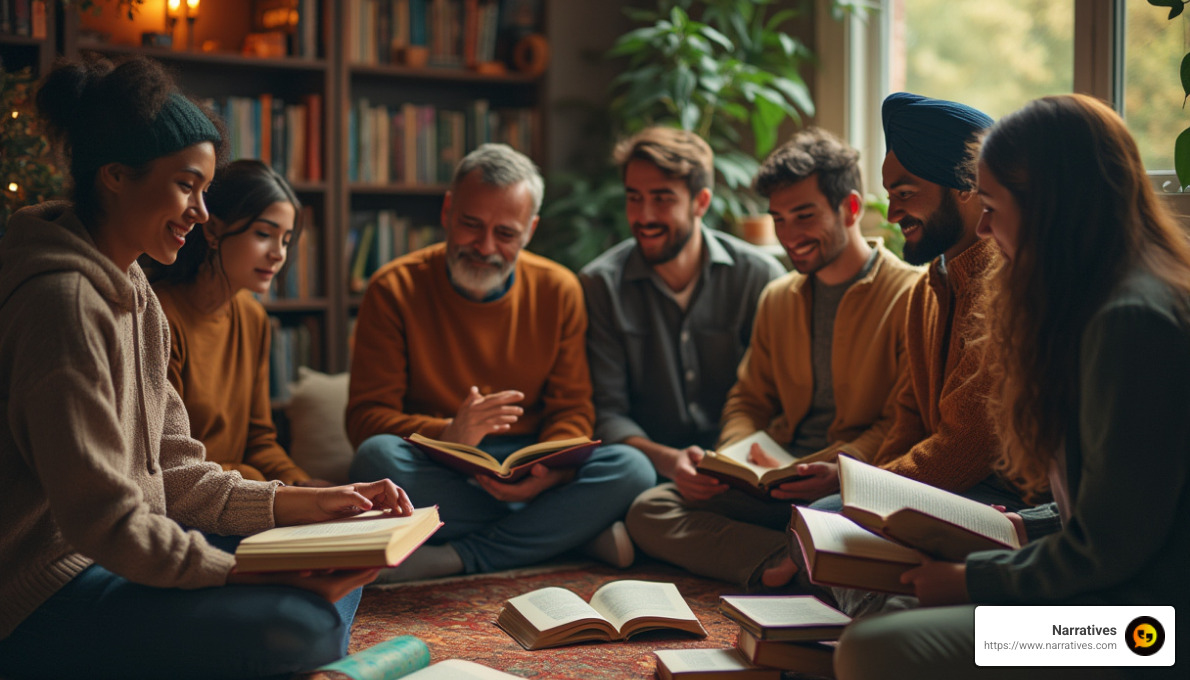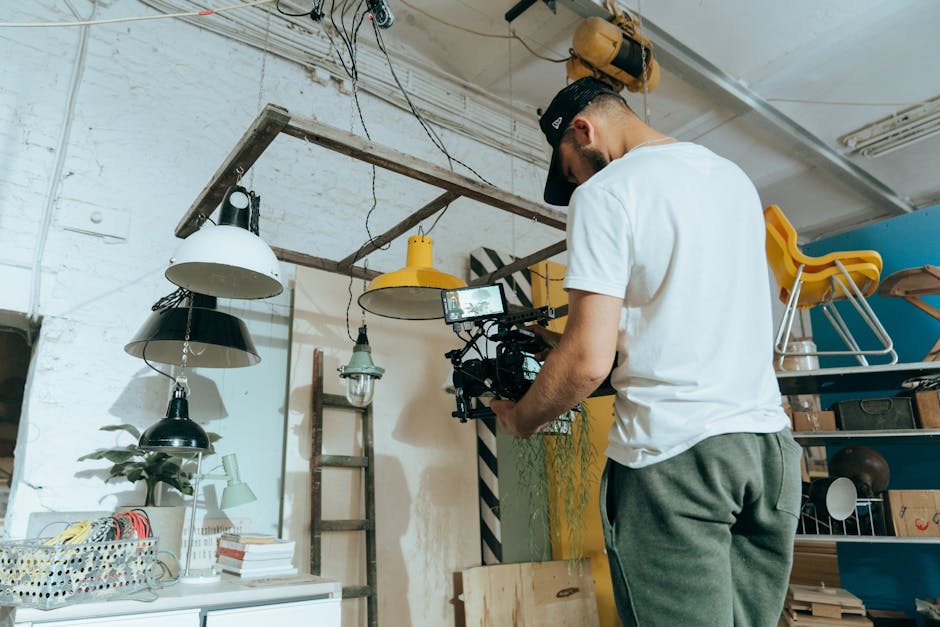Narrative Networks: How Storytelling Projects Unite Communities
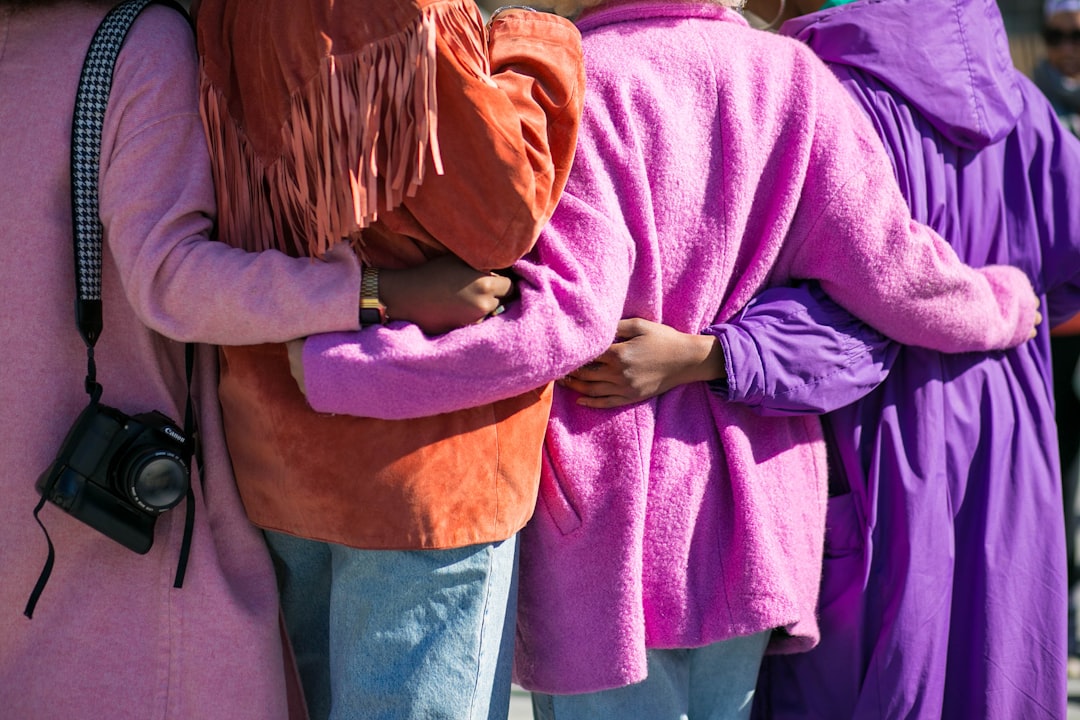
Community storytelling projects bring people together in powerful ways. They provide a platform for individuals to share their personal stories, fostering a sense of inclusion and community belonging. Here's why these projects are so impactful:
They bridge gaps: By sharing experiences, storytelling helps break down barriers between different groups within a community.
They give voice to the unheard: Community storytelling projects shine a light on stories that often go unnoticed, amplifying diverse voices.
They promote inclusivity: These projects encourage participation from all community members, making everyone feel valued and included.
They build connections: Storytelling creates a shared understanding and helps build stronger, more connected communities.
Community storytelling projects are not just about sharing tales; they are about creating bonds and fostering a deeper sense of belonging. Whether it's through digital platforms or face-to-face gatherings, these projects harness the power of narratives to unite and inspire.
In today's interconnected world, the importance of storytelling as a tool for community and inclusion is more significant than ever. As societies face numerous challenges, turning to these narrative networks can offer a guide of light.
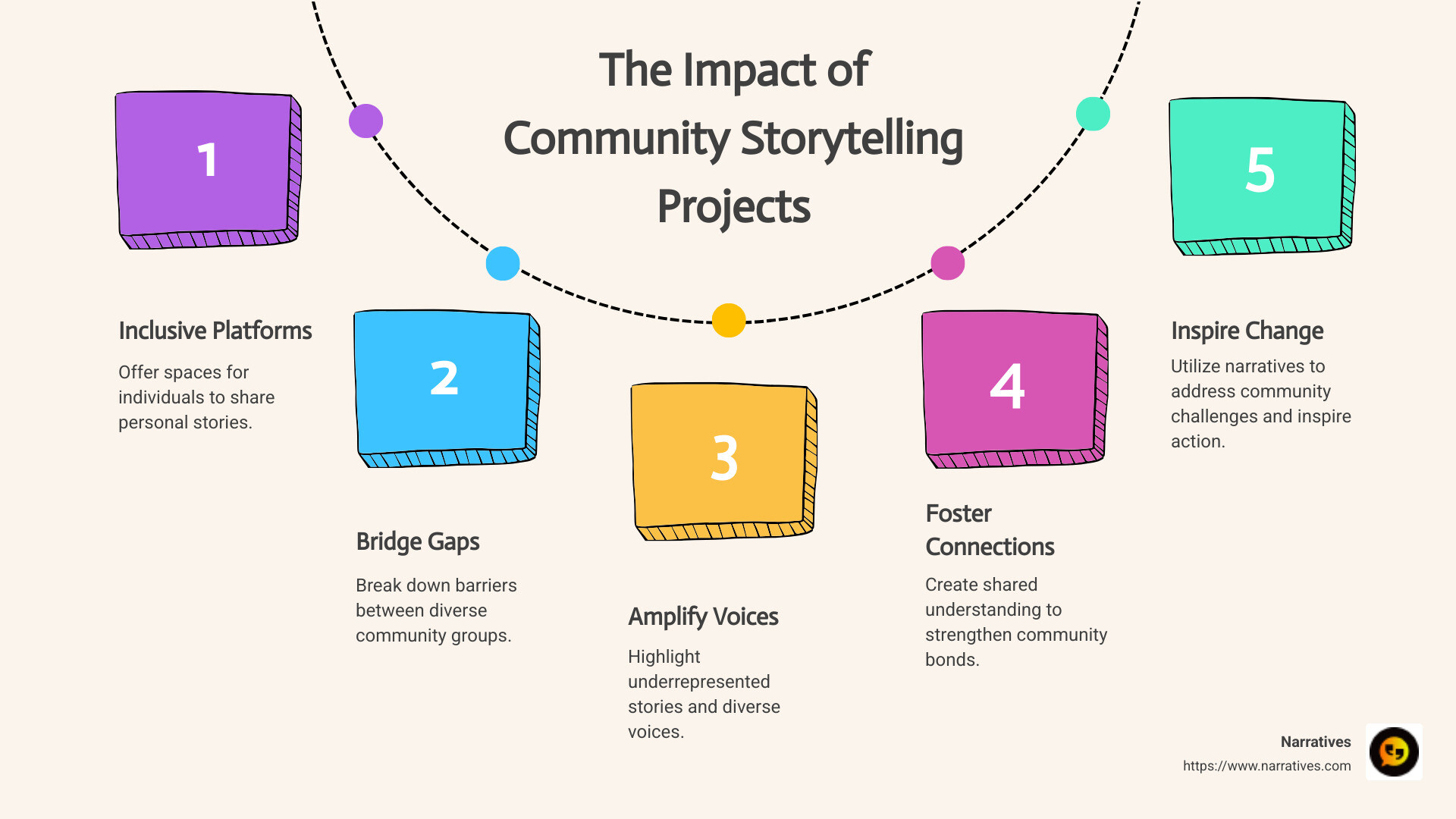
The Power of Community Storytelling Projects
Community storytelling projects are more than just a collection of tales; they are a bridge to understanding and unity. By weaving together personal stories, these projects tap into the rich mix of oral history and local knowledge, offering profound insights into the heart of a community.
Community Storytelling: A Catalyst for Change
Storytelling has the power to transform communities. When people share their stories, they find common ground, fostering trust and empathy. For instance, in a racially and ethnically divided neighborhood, storytelling sessions revealed shared concerns among residents, like the desire for safe play spaces for children. This commonality helped to bridge cultural divides and promote community cohesion.
Unearthing Local Knowledge Through Oral History
Oral history is a treasure trove of local knowledge. It captures the lived experiences and wisdom of community members, which might otherwise be overlooked. Projects like "Community Roots" empower participants to learn interviewing techniques, gather stories, and activate them through public programming. This process not only preserves valuable history but also highlights the community's strengths and assets.
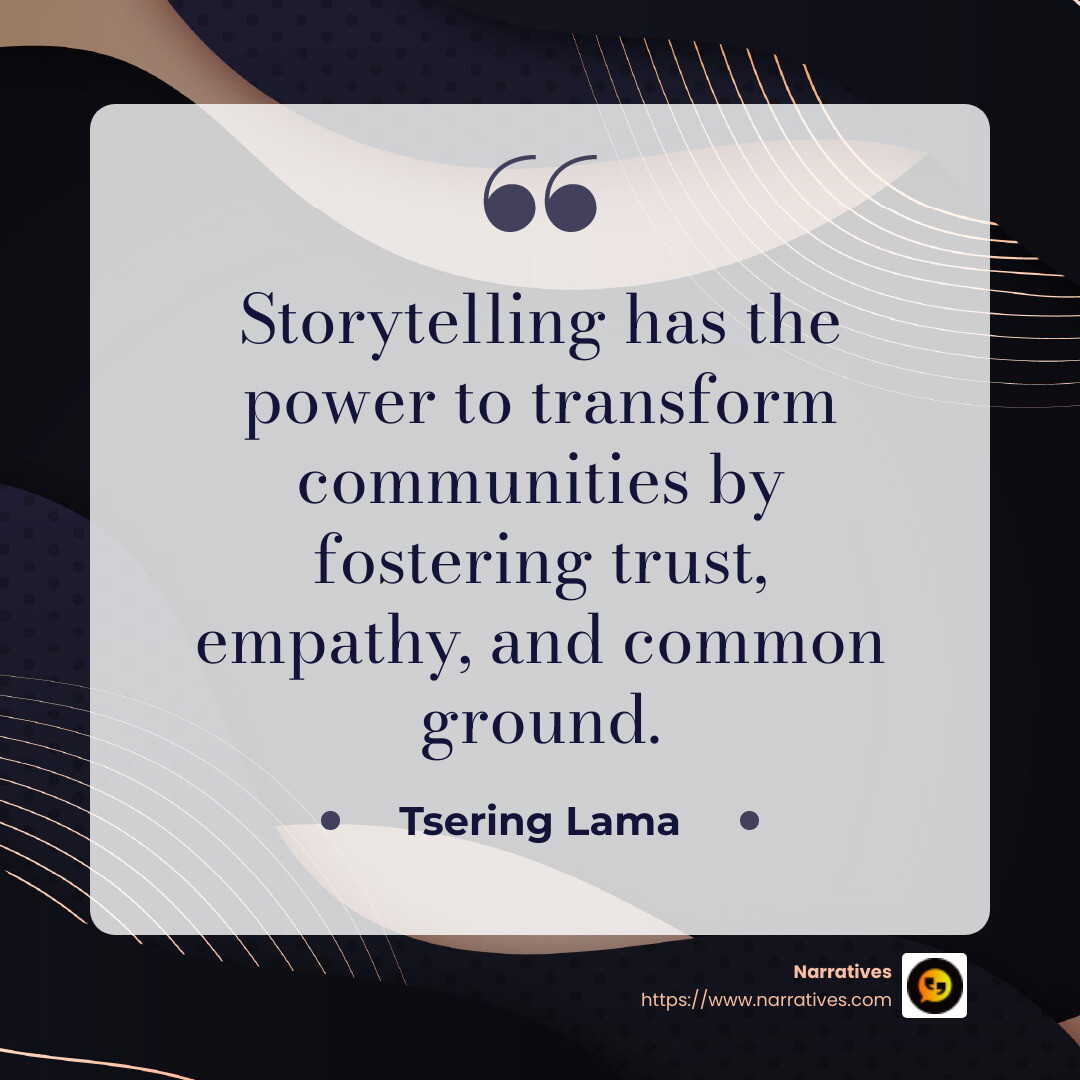
Shifting the Narrative to What Communities Have
Often, communities are defined by what they lack. However, community storytelling projects can shift the focus to what they possess. By highlighting intangible assets, such as cultural traditions or shared histories, these projects inspire communities to leverage their strengths for development. As one community learned, the question became, How can we leverage what we do have to get what we need?
Building Social Resilience
Participatory storytelling fosters social resilience by encouraging community-led development. When communities take ownership of their narratives, they are more likely to believe in their capacity for change. As seen in projects like "The Third Thirty," storytelling sessions reflect the progress made and instill a belief in the possibility of continued improvement.
In summary, community storytelling projects are a powerful tool for fostering development and resilience. They bridge gaps, amplify unheard voices, and help communities realize their potential. By embracing these projects, communities can unite to face challenges and envision a brighter future.
Key Elements of Successful Storytelling Projects
When we talk about community storytelling projects, we're diving into a world where stories come alive in unique and impactful ways. Let's explore what makes these projects successful.
Unique Projects: The Heartbeat of Storytelling
Every community has its own unique stories to tell. Projects like "Unsung Women of West Penwith" shine a light on overlooked narratives, celebrating the resilience and contributions of women who have shaped their communities. By focusing on these unique tales, storytelling projects can highlight diversity and foster a sense of pride and belonging.
Digital Stories: Bringing Narratives to Life
Digital storytelling is a game-changer. It transforms traditional tales into interactive experiences. Projects like the "Gwelan Podcasts" use digital media to explore the rich history and culture of Mounts Bay. Through podcasts, films, and online exhibitions, community members can experience stories in new ways, making history accessible and engaging for all ages.
Personal Stories: The Power of Individual Voices
At the core of any successful storytelling project are personal stories. These are the narratives that connect us on a human level. In the "Robertson Family Collection Object Stories," personal accounts of survival at sea became a powerful reminder of resilience and hope. By focusing on individual experiences, storytelling projects create empathy and understanding, breaking down barriers and building connections.
Integrating Elements for Success
To sum up, successful storytelling projects blend unique narratives, digital innovation, and personal voices. This combination not only preserves history but also engages communities in meaningful ways. By embracing these elements, storytelling projects can become powerful tools for unity and change.
How Storytelling Projects Foster Community Development
Community-Led Development: Empowering Local Voices
Community storytelling projects are a catalyst for community-led development. By encouraging communities to share their own stories, these projects empower individuals to take charge of their narratives and futures. For example, in Maryland, a community organizer found that by listening to personal stories, residents were inspired to envision and work towards a brighter community. This approach shifts the focus from external help to internal empowerment, enabling communities to become active participants in their own development.
Social Resilience: Building Stronger Communities
Storytelling plays a crucial role in enhancing social resilience. In post-disaster scenarios, like the aftermath of earthquakes in Kathmandu, storytelling has been instrumental in rebuilding community spirit. By sharing their experiences, residents not only process trauma but also find strength in solidarity. This collective resilience is vital for recovery and rebuilding efforts. Public spaces, transformed into storytelling hubs, become arenas for cooperation and healing, fostering a sense of togetherness and mutual support.
Participatory Storytelling: Engaging and Uniting
Participatory storytelling invites everyone to the table, breaking down barriers of language, age, and background. This inclusive approach ensures that all voices are heard, particularly those often marginalized. In projects like "Our Bude, Our Stories," community members contribute their memories and reflections, creating a rich mix of shared experiences. By asking participants how they can bring their imagined communities to life, storytelling projects not only gather stories but also inspire action and collaboration.
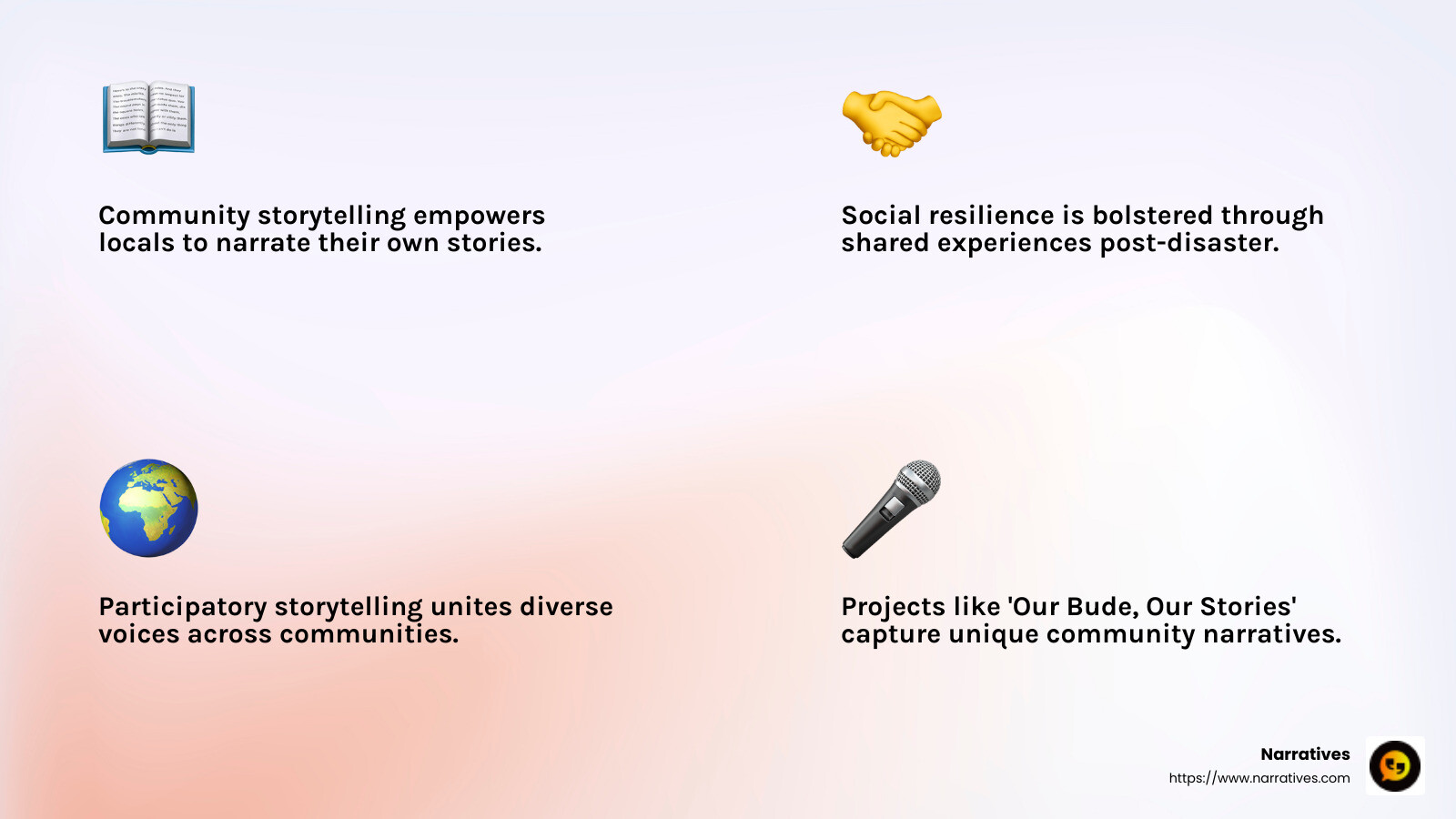
Through these elements, community storytelling projects become more than just a collection of tales. They are powerful tools for fostering community development, promoting resilience, and encouraging active participation. These projects continue to unite and strengthen communities, one story at a time.
Community Storytelling Projects: Examples and Impact
Community storytelling projects are changing the way we connect and understand each other. Let's explore some inspiring examples that highlight their impact.
Unsung Women of West Penwith
In West Penwith, women have long been the backbone of their communities, yet their stories often go untold. The "Unsung Women of West Penwith" project shines a light on these remarkable women, documenting their contributions to homes, livelihoods, and local industries. By bringing these stories to the forefront, the project not only honors these women but also strengthens community ties by acknowledging the pivotal roles women have played.
Withy Lore
The craft of making withy pots, traditional willow crab and lobster pots, is a fading art. Through "Withy Lore," Storylines and Anna Pope are preserving this cultural heritage. By recording oral histories and filming the pot-making process, they connect generations and keep the tradition alive. The project will culminate in an exhibition at the Cornwall Museum and Art Gallery, showcasing the artistry and stories behind withy pots.
Robertson Family Collection Object Stories
The Robertson family's survival story is nothing short of extraordinary. After being shipwrecked by killer whales in 1972, they survived 38 days at sea. Storylines captured their experiences in a series of films for the National Maritime Museum Cornwall. These films focus on the objects that saved their lives, offering a unique perspective on resilience and survival.
Gwelan Podcasts - Mounts Bay
The "Gwelan Podcasts" series digs into the rich history and ecology of Mounts Bay. Inspired by the submerged forest in the bay, these podcasts share diverse perspectives from locals and experts. By exploring geology, ecology, and cultural history, the series fosters a deeper understanding and appreciation of the area's unique environment.
Our Bude, Our Stories
In Bude, community storytelling is being used to address climate change. As part of the Bude Climate Partnership, "Our Bude, Our Stories" collects memories and reflections to create digital stories. These stories form innovative toolkits that help the community share memories and learn from each other. By focusing on heritage, culture, and environment, the project encourages residents to consider what's important for their future in a changing climate.
These community storytelling projects illustrate the transformative power of sharing stories. They not only preserve cultural heritage but also foster a sense of belonging and inspire positive change. As these projects continue to evolve, they remind us of the strength found in our shared narratives.
Frequently Asked Questions about Community Storytelling Projects
What is a storytelling repertoire?
A storytelling repertoire is a collection of stories, techniques, and methods that storytellers use to engage their audience. It includes personal anecdotes, historical narratives, and cultural tales that reflect the storyteller's experiences and the community's heritage. This repertoire helps storytellers convey complex ideas in relatable ways, making information accessible and engaging. By sharing diverse stories, communities can strengthen their collective identity and ensure that important narratives are passed down through generations.
How do storytelling projects promote inclusion?
Storytelling projects foster inclusion by creating spaces where everyone can share their stories, regardless of background or experience. These projects often involve inclusion workshops and participatory storytelling, where community members are encouraged to contribute their voices. For instance, in Maryland, asking immigrants to share their dreams for their community made storytelling less intimidating and more inclusive. By focusing on personal stories, projects validate individual experiences and encourage participation from those who might otherwise feel marginalized. This approach not only amplifies diverse voices but also fosters empathy and understanding within the community.
What are some examples of community storytelling projects for students?
Community storytelling projects offer valuable opportunities for students to engage with their local history and culture. Oral history projects are a popular format, where students interview community members to capture their stories. This hands-on approach helps students develop listening and interviewing skills while learning about their community's past. In projects like "The Third Thirty," students in South Sound interviewed elders, gaining insights into the wisdom and experiences of older generations.
For college students, storytelling projects can be integrated into coursework, allowing them to explore topics like social justice, heritage, and identity. These projects often culminate in public presentations or digital stories, providing students with a platform to share what they've learned and contribute to their community's narrative. By participating in storytelling projects, students not only improve their academic experience but also build connections with their community.
Conclusion
Narratives are more than just stories; they are powerful tools that can drive social impact and foster meaningful connections. At Narratives, we believe in the transformative potential of storytelling to lift underrepresented voices and inspire change. Our work with non-profit partnerships focuses on creating high-quality, emotionally resonant multimedia content that helps organizations share their impact stories effectively.
By focusing on community storytelling projects, we empower communities to tell their own stories. This approach not only increases visibility for important causes but also builds trust and encourages action. Through these projects, communities can harness local knowledge and oral history to drive community-led development and social resilience.
Our partnerships with non-profits are key to amplifying these voices. By collaborating with organizations dedicated to social justice and community empowerment, we ensure that the stories shared are authentic and impactful. This collaboration helps non-profits reach wider audiences and achieve their goals more effectively.
As we continue to support community storytelling, we invite you to learn more about how our services can help your organization. Together, we can create stories that unite communities and drive meaningful change.
